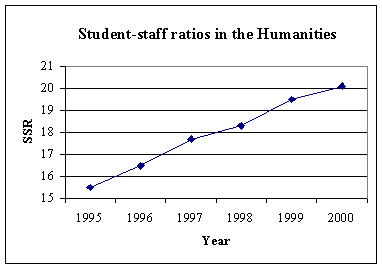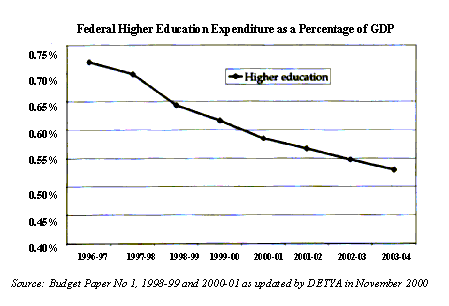Professor Sue Serjeantson is Executive Secretary of the Australian Academy of Science and for four years was Director of the Australian National University's Institute of Advanced Studies. A bit over a year ago, December 8th, as the President of the Federation of Australian Scientific and Technological Societies she pointed out, "The Australian Bureau of Statistics estimates that at the rate we are going in buying technology off the shelf overseas, our Budget deficit in information technology and telecommunications alone will be $28.8 billion in 2010-11... We need to be a whole lot more than a smart buyer of technology. We have to invest in our ideas and export our innovative products."
The Government's answer for "doing a whole lot more" has been to provide an additional $2.9 billion in Backing Australia's Ability over five years -- $159 million scheduled for 2001-02, increasing to $947 million for 2005-06. It also transpires that a particular rationalisation has accompanied the Coalition's parsimony, namely that Australia should aspire to be a close follower of the leading innovative nations. There appears to be no precise definition of what is meant by "being a close follower" but it certainly implies that striving for native excellence is not of high priority, and when it comes to garnering votes there are sufficient current indications that Mr. Howard's populist government has got it pretty right. On the other hand if it comes to the welfare of the nation he's got it terribly wrong. The insidiousness of the matter likens it to an infection with HIV rather than Ebola. Both are deadly but HIV may take years before it wreaks its appalling penalties, Ebola administers it coup de grâce in days. Ralph Waldo Emerson's admonition, "Do not go where the path may lead, go instead where there is no path and leave a trail," doesn't appear to be held in high regard in Canberra.
A couple of graphs and a small table to make the point:
Advertisement


According to the Group of Eight the additional five-year funds required to lift Australia's investment in R&D by 2005 to a level comparable with the 1998 OECD average of just over 2% of GDP needs to be $13.65 billion, by which time the OECD mean is expected to have risen a further 10% to 2.2% of GDP.
|
Source |
Additional Investment
($billions) |
| Business |
4.20 |
| Commonwealth |
6.75 |
| Non-Commonwealth |
2.70 |
|
TOTAL |
13.65 |
But if the murmurings coming from Canberra are more than mere speculation we are missing the point. We don't need to be up with the likes of the 1998 OECD AVERAGE nation, we need only to follow close behind. But how close is close? Even the Group of Eight's figures hardly indicate an aggressive scenario for moving Australia to the forefront of research and development. Following the Gof8 schedule we would achieve %GDP par with an OECD average nation during 2008-09 if the players in the table above all pull their weight and continued the additional funding.
Yet that proposal is well over the top so far as the Federal Coalition is concerned. It's as though that $2.9 billion to "Back Australia's Ability" is primarily to enhance our scavenging skills; i.e. its 43% of the $6.75 billion proposed by the Gof8. In fact the Government's proposal will at best, according to the Group of Eight's estimate, maintain Australia's R&D investment at the current percentage of GDP while the rest of the developed nations move on with deliberate speed; in short the dining table will be moved further and further out of reach making it all the more difficult to make a diving catch for the falling crumbs.
Advertisement
Leaving the metaphors aside, why is the vague concept of being a close follower arrant nonsense?
If Australia's tertiary educational system is poor, i.e. has outmoded facilities, few outstanding members of staff, and is chronically under funded, it will attract no better than mediocrity as either new staff or foreign students. The harsh truth is that, " 'ems as has, gits". So for example Harvard, Stanford, MIT, the University of California, Berkeley can attract among the best.
With very rare exceptions, top flight researchers have had outstanding mentors. Outstanding mentors rarely stay at mediocre institutions. According to Alan Gilbert, Vice-Chancellor of Melbourne University, Australia's best universities wouldn't make it into the top 100. If our best tennis player weren't in the top 100... too horrible to contemplate.
The Senate committee tells us our universities are in crisis. "Rubbish," replies the Government, "your report is politically motivated as well as being un-Australian."
Our universities do graduate men and women of marked potential in research and academe. They invariably go overseas to further their training. The best will be offered positions at outstanding overseas institutions not to return. Were they to do so they would be faced with poor funding, inadequate facilities and at best a marginally stimulating intellectual climate.
Is this then the environment that is to produce the individuals who will create Australia's innovative culture and industries? Not very likely. Is this the environment that is to attract and keep the best of overseas intellects to assist in furthering Australia's future? Not too likely.
Who then are to be those individuals who will have the ability to comprehensively utilise the science and technologies to fuel our exports so that we can pay for those imports? And what will we provide in order to keep and attract them?
As competitors we have nations that are trade rivals because they produce goods and services more cheaply through using cheap labour.
As competitors we have nations that are trade rivals because they produce goods and services more cheaply through the use of highly efficient methods of production.
And finally there are nations which produce goods and services with which we cannot compete because we do not have the expertise.
One of the most important reasons we have remained internationally competitive is (1), i.e. the value of the Australian dollar has dropped significantly since 1996. The critical comparison is the Trade Weighted Index and which gives the lie to the assertion that the devaluation of the Australian dollar is merely the high US dollar.

Value of the Australian dollar versus the US$__ and the
Trade Weighted Index (TWI) __ since it was floated.
(Taken from the Reserve Bank's Nov. 2000 Report)
In certain primary industries Australia is an efficient producer. However, maintaining such efficiency requires increasingly more sophisticated technology which Australia must import to a major extent. As the dollar cheapens, that costs us more. And that is a downward spiral waiting to happen.
To implement productive efficiency (2) and to develop means to produce competitive technologically advanced goods and services (3) requires an educational infrastructure of top world standard, the point Professor Anderson made when promulgating the Australian Academy's recommendations prior to the Federal election in November. "Australia needs to invest in something it can be confident will build a better nation. Education means jobs for young people in knowledge-based industries. Science means innovation for those industries." All the Governmental protestations and obfuscations are not going to change that.
Were the Government to heed the call of the Australian Academy of Science and its fellow organisations immediately it would take us until 2008 at the earliest to catch up to the OECD mean. So far the government has paid scant heed and despite Rupert Murdoch's rapid-fire high-altitude strafing in October, the media have been markedly ho-hum. Over the past decades we've seen our waterways become increasingly polluted and overtaxed. The proportion of our arable land suffering increasing salinity is accelerating. Yet only recently has there been a glimmer of awareness by media, public and government that these are matters of serious national concern. Just how degraded do our universities need to become before the problem is recognised as having dire consequences for the nation. On the other hand, were it a matter of the petrol excise ...